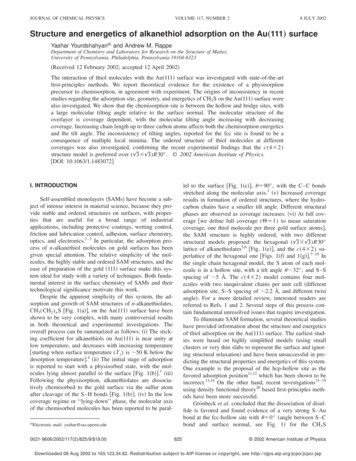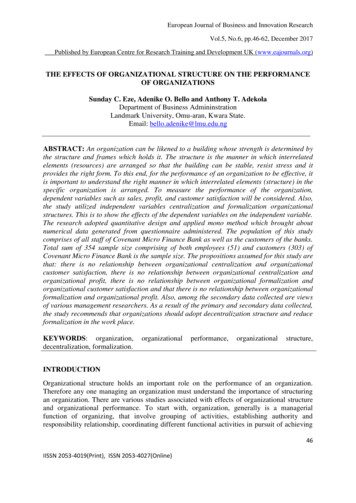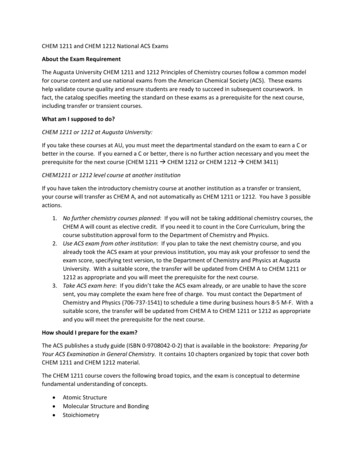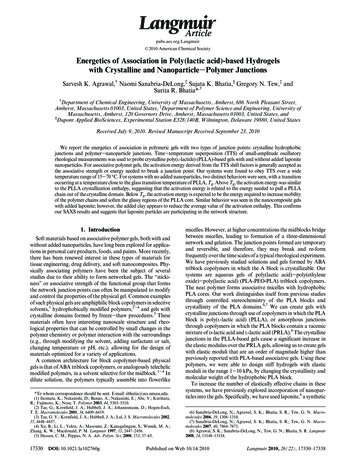
Transcription
JOURNAL OF CHEMICAL PHYSICSVOLUME 117, NUMBER 28 JULY 2002Structure and energetics of alkanethiol adsorption on the Au„111 surfaceYashar Yourdshahyana) and Andrew M. RappeDepartment of Chemistry and Laboratory for Research on the Structure of Matter,University of Pennsylvania, Philadelphia, Pennsylvania 19104-6323共Received 12 February 2002; accepted 12 April 2002兲The interaction of thiol molecules with the Au共111兲 surface was investigated with state-of-the-artfirst-principles methods. We report theoretical evidence for the existence of a physisorptionprecursor to chemisorption, in agreement with experiment. The origins of inconsistency in recentstudies regarding the adsorption site, geometry, and energetics of CH3 S on the Au共111兲 surface werealso investigated. We show that the chemisorption site is between the hollow and bridge sites, witha large molecular tilting angle relative to the surface normal. The molecular structure of theoverlayer is coverage dependent, with the molecular tilting angle increasing with decreasingcoverage. Increasing chain length up to three carbon atoms affects both the chemisorption energeticsand the tilt angle. The inconsistency of tilting angles, reported for the fcc site is found to be aconsequence of multiple local minima. The ordered structure of thiol molecules at differentcoverages was also investigated, confirming the recent experimental findings that the c(4 2)structure model is preferred over () ))R30 . 2002 American Institute of Physics.关DOI: 10.1063/1.1483072兴lel to the surface 关Fig. 1共c兲兴, 90 , with the C–C bondsstretched along the molecular axis.1 共v兲 Increased coverageresults in formation of ordered structures, where the hydrocarbon chains have a smaller tilt angle. Different structuralphases are observed as coverage increases. 共vi兲 At full coverage 关we define full coverage ( 1) to mean saturationcoverage, one thiol molecule per three gold surface atoms兴,the SAM structure is highly ordered, with two differentstructural models proposed: the hexagonal () ))R30 lattice of alkanethiolates5,6 关Fig. 1共e兲兴, and the c(4 2) superlattice of the hexagonal one 关Figs. 1共f兲 and 1共g兲兴.7–10 Inthe single chain hexagonal model, the S atom of each molecule is in a hollow site, with a tilt angle 32 , and S–Sspacing of 5 Å. The c(4 2) model contains four molecules with two inequivalent chains per unit cell 共differentadsorption site, S–S spacing of 2.2 Å, and different twistangle兲. For a more detailed review, interested readers arereferred to Refs. 1 and 2. Several steps of this process contain fundamental unresolved issues that require investigation.To illuminate SAM formation, several theoretical studieshave provided information about the structure and energeticsof thiol adsorption on the Au共111兲 surface. The earliest studies were based on highly simplified models 共using smallclusters or very thin slabs to represent the surface and ignoring structural relaxation兲 and have been unsuccessful in predicting the structural properties and energetics of this system.One example is the proposal of the hcp-hollow site as thefavored adsorption position11,12 which has been shown to beincorrect.13,14 On the other hand, recent investigations13–19using density functional theory20 based first-principles methods have been more successful.Grönbeck et al. concluded that the dissociation of disulfide is favored and found evidence of a very strong S–Aubond at the fcc-hollow site with 0 共angle between S–Cbond and surface normal, see Fig. 1兲 for the CH3 SI. INTRODUCTIONSelf-assembled monolayers 共SAMs兲 have become a subject of intense interest in material science, because they provide stable and ordered structures on surfaces, with properties that are useful for a broad range of industrialapplications, including protective coatings, wetting control,friction and lubrication control, adhesion, surface chemistry,optics, and electronics.1–3 In particular, the adsorption process of n-alkanethiol molecules on gold surfaces has beengiven special attention. The relative simplicity of the molecules, the highly stable and ordered SAM structures, and theease of preparation of the gold 共111兲 surface make this system ideal for study with a variety of techniques. Both fundamental interest in the surface chemistry of SAMs and theirtechnological significance motivate this work.Despite the apparent simplicity of this system, the adsorption and growth of SAM structures of n-alkanethiolates,CH3 (CH2 ) n S 关Fig. 1共a兲兴, on the Au共111兲 surface have beenshown to be very complex, with many controversial resultsin both theoretical and experimental investigations. Theoverall process can be summarized as follows: 共i兲 The sticking coefficient for alkanethiols on Au共111兲 is near unity atlow temperature, and decreases with increasing temperature关starting when surface temperature (T s ) is 50 K below thedesorption temperature兴.4 共ii兲 The initial stage of adsorptionis reported to start with a physisorbed state, with the molecules lying almost parallel to the surface 关Fig. 1共b兲兴.1 共iii兲Following the physisorption, alkanethiolates are dissociatively chemisorbed to the gold surface via the sulfur atomafter cleavage of the S–H bonds 关Fig. 1共b兲兴. 共iv兲 In the lowcoverage regime or ‘‘lying-down’’ phase, the molecular axisof the chemisorbed molecules has been reported to be parala兲Electronic mail: yashar@sas.upenn.edu0021-9606/2002/117(2)/825/9/ 19.00825 2002 American Institute of PhysicsDownloaded 08 Aug 2002 to 165.123.34.82. Redistribution subject to AIP license or copyright, see http://ojps.aip.org/jcpo/jcpcr.jsp
826J. Chem. Phys., Vol. 117, No. 2, 8 July 2002Y. Yourdshahyan and A. M. RappeFIG. 1. The following are illustrated: 共a兲 n-alkanethiol molecule 共b兲 interaction potential between thiol molecule and Au共111兲 surface, 共c兲 decreasing tilt angle, , with increasing coverage, , 共d兲 the symmetry of the c(4 2) model, where molecules 1 and 2 are equivalent but distinct from 3 and 4, 共e兲 hexagonal() ))R30 structure model, and 共f兲 and 共g兲 two different structural model for the c(4 2) superlattice.molecule.13 Our recent study of the effect of coverage andchain length on thiolate adsorption 共restricted to tilt anglesnear 0 兲 pointed to the fcc-hollow site as the most stableposition, independent of coverage and chain length.14 A recently published study by Hayashi et al. investigated CH3 Sadsorption at low and high coverage. Their results show thestable ground-state configuration of methylthiolate at fullcoverage to be a strongly tilted S–C bond at the bri-fcc site共shifted from the bridge site toward the fcc site兲 with a tiltangle of 52.7 and adsorption energy E ad 0.54 eV withrespect to the free dimethyl-disulfide. The study by Akinagaet al. examined adsorption of thiol molecules on differentmetal surfaces, also reporting the bri-fcc site as the favoredadsorption position in the case of Au共111兲,16 with 51.94 and E ad 1.84 eV with respect to free CH3 S. Thestudy performed by Vargas et al. proposed the bridge site asthe stable site for adsorption regardless of coverage 共veryweak dependency was reported兲. They also reported thatthe adsorption energy of the thiol molecule at fcc sitechanges from 0.78 to 0.13 eV for of 0.25 to 1, respectively. The presented reason was different surface relaxationat different .17 Finally, the study performed by Gottschalket al.19 at 0.75 reported the bri-fcc site for adsorption共 61.1 and E d 1.72 eV with respect to free CH3 S兲. Theauthors proposed steric repulsion between the Au and methylgroup to be the reason for adsorption at the bridge site.Even though the majority of recent studies point to brifcc site as the minimum energy adsorption site, there are stillsome disagreements, including the tilting angle of the S–Cbond, coverage dependency, and the adsorption energy. Theobjective of this paper is to understand the thiol interactionwith gold surface in the initial stages of the adsorption process and the ordered SAM structure at full coverage. Thisstudy is performed with state-of-the-art first-principles calculations, based on density-functional theory 共DFT兲.20 All ofthe first-principles calculations have been performed with theplane-wave pseudopotential code ‘‘DACAPO.’’ 21 The paper isorganized as follows: Section II briefly presents the methodand calculational details used throughout this investigation.In Sec. III, the results for adsorption of thiol on gold arepresented and discussed. In Sec. IV, conclusions and outlookare presented.II. COMPUTATIONAL DETAILSThe framework of the computational method used in thisinvestigation is DFT,20 using the code ‘‘DACAPO.’’ 21 Exchange and correlation 共XC兲 are treated with the PBE formof the generalized gradient approximation 共GGA兲.22 Theelectron–ion interactions are described by ultrasoft pseudopotentials 共USPPs兲.23 New pseudopotentials, H (1s 1 ),C (2s 2 2 p 2 ), S (3s 2 3 p 3.53d 0.5), and Au (5d 9.56s 1 6p 0.5),were generated within the USPP scheme using the PBE XCfunctional22 共including relativistic effects and core corrections兲 with cutoff radii (r c ) of 0.60, 1.24, 1.45, and 2.00bohr, respectively. The transferability error in all generatedpotentials is in the meV range.14 The plane wave cutoff istaken to be 25 Ry, which provides good total energy convergence. The Brillouin zone is sampled according to theMonkhorst–Pack method.24 To improve the k-point convergence, the Fermi discontinuity is smoothed using temperature broadening with an effective electron temperature of 0.1eV.25The choice of slab size 共6 Au layer兲, k points 共2– 6兲, andcutoff energy 共25–30 Ry兲 is based on our tests in previouslypublished work, which show converged calculations with anerror of about 0.01 eV.14 To assess the reliability of ourmethod, and in particular the quality of the generatedpseudopotentials, extensive calculations for properties ofbulk and surface Au, and energetics of thiol molecules共RS–H and RS–SR, RvCH3 兲 in the gas phase were carriedout. The results are summarized in Table I.The theoretical results show higher lattice constants,lower surface energies, and lower bulk moduli than experiment for gold. This is a well-known effect of the GGA. Theaccuracy of our pseudopotentials is confirmed by excellentagreement with all-electron results. Furthermore, all investigations have difficulty in reproducing the experimental values of binding energy for RS–H and RS–SR (RvCH3 ).This difficulty will certainly affect the quality of calculatedDownloaded 08 Aug 2002 to 165.123.34.82. Redistribution subject to AIP license or copyright, see http://ojps.aip.org/jcpo/jcpcr.jsp
J. Chem. Phys., Vol. 117, No. 2, 8 July 2002Alkanethiol adsorption on Au(111)827TABLE I. The bulk and surface parameters of gold and the energetics of thiol molecules. Lattice constant a 共Å兲,bulk modulus, B 共MPa兲, surface energy, 共J/m2兲, cohesive energy, E coh 共eV兲, of gold, and binding energies:E d(RS–H) and E d (RS–SR) in 共eV兲, R CH3 . The theoretical results are based on plane wave pseudopotential共PWPP兲 or the full potential linearized augment plane wave 共FPLAPW兲 methods with either PBE, PW91, orRPBE XC functional.Ref.Method 共functional兲This work13151719262, 27, 28PWPP 共PBE兲PWPP 共PW91兲PWPP 共PW91兲PWPP 共PW91兲PWPP 共RPBE兲FPLAPWExpt.aBE .7584.1804.160142.04.058 – 4.080 172.0–173.2 1.045–1.500adsorption energies. A comparison between LDA and GGAshows that LDA overbinds even more.13 The alternativeRPBE functional has shown many excellent results for binding energies. For this system, it is worth noting that theRPBE functional does not show promising results.19III. RESULTS AND DISCUSSIONStudy of a long chain thiol molecule interacting with thegold surface is computationally challenging due to the complexity of the system. Therefore, we chose to investigate theinteraction of short-chain thiol molecules 共up to three carbonatoms兲 with the Au共111兲 surface. The calculations presentedhere focus on the initial stages of adsorption, and results arecompared to the experimental and other theoretical studies.The adsorption energies have been calculated asE ad 共 E SAM E Au E mol兲 ,where, E SAM , E Au , and E mol represent the total energy of theSAM system 共adsorbant plus substrate兲, clean gold surface,and the adsorbant molecule in gas phase, respectively.A. Search for physisorption stateIt has been reported that at low surface temperature (T s )and coverage 共 兲, the dominant pathway to chemisorption isthrough physisorption.1,4,29 In this state, alkanethiol molecules become trapped in the physisorption well for a relatively long period. The effective barrier height toward chemisorption has been estimated to be 0.3 eV, independent ofchain length 共for n 6兲. The physisorption energies, E phys ,for methanethiol, ethanethiol, and decanethiol have been reported to be 0.50, 0.59, and 1.08 eV, respectively.4,29 Interpolating the presented values yields an estimated E phys forCH3 CH2 SH of 0.54 eV.Even though the van der Waals interaction, which is themajor driving force for physisorption, is not included correctly in the current DFT functional, we attempt to study thisinitial stage to see if the physisorbed state could be distinguished. We performed a number of calculations usingCH3 SH, CH3 CH2 SH, and CH3 (CH2 ) 2 SH molecules adsorbed on the Au共111兲 surface 共12 Au atoms per layer, 0.25兲. Molecules were placed with 0 and 90 , at adistance, d S-Surf , of 5, 3.5, and 2.8 Å to the surface, and thenthe hydrocarbon chain was relaxed.E coh E d(RS–H) E 2.773.043.053.732.81We find that far from the surface, the thiol moleculesprefer to stay in the stretched zigzag C–C–C line with molecular axis almost parallel to the surface 共Fig. 2兲, 87 ,and adsorption energies of 0.07, 0.08, and 0.10 eV for eachrespective molecule. We also notice that the increase in C–Cbond length is chain length dependent 关 d C–C 3% and 8%for CH3 CH2 SH and CH3 (CH2 ) 2 SH, respectively兴. As thedistance decreases, the molecules start to relax, making asmall angle with the surface. Noticeable is the trend of decreasing adsorption energy with shorter chains, which agreeswith experimental results.A careful search for the physisorption state of theCH3 CH2 SH molecule was carried out by calculating the totalenergy of the system with much smaller changes of d S-Surf .The results show a physisorption state with an adsorptionenergy of 0.32 eV at 3.35 Å from the surface. The heightof the calculated barrier toward chemisorption is 0.09 eV共Fig. 2兲. Unfortunately, these values are much smaller thanthe values estimated from experimental work. This is notsurprising at all, due to incomplete description of van derWaals interaction in our method and the fact that the choiceof molecular orientation and the adsorption site will affectthe calculated barrier. Unfortunately, it is very hard to identify the true reaction coordinate at this state of adsorptionmechanism due to the complex nature of the system. However, it is gratifying to find qualitative agreement with ex-FIG. 2. Schematic picture of structural orientation for physisorbed state. Themolecule is positioned over the fcc site, almost parallel to the surface withdistance d S-Surf 3.35 Å, from the surface plane.Downloaded 08 Aug 2002 to 165.123.34.82. Redistribution subject to AIP license or copyright, see http://ojps.aip.org/jcpo/jcpcr.jsp
828J. Chem. Phys., Vol. 117, No. 2, 8 July 2002Y. Yourdshahyan and A. M. RappeFIG. 3. Schematic picture of a DMDS molecule adsorbed on a Au共111兲surface. (Z1 , 1 ) and (Z2 , 2 ) are distances from the surface plane and molecular angles with the surface normal for each S atom.periment, and quantifying the magnitude of DFT error is auseful benchmark for future work in this era.B. Energetics and structure of thiolate adsorptionThe next step of the adsorption process is dissociationand chemisorption. To investigate these states, the interactionof (CH3 S) 2 , CH3 S, CH3 CH2 S, and CH3 (CH2 ) 2 S moleculeswith Au共111兲 surface have been studied. Even though thesemolecules are the smallest thiol molecules, they do present avariety of difficulties when investigated theoretically. A freealkanethiolate molecule prefers a zigzag C–C–C conformation with a twist angle 共 兲 around the molecular axis, whichvaries with the chain length. When a metal surface is exposed to this molecule, the head group 共S兲 location and thetwo angular dependencies, and 关Fig. 1共a兲兴, will play animportant role in adsorption energetics.1. Adsorption of dimethyl disulfideExperimental and recent theoretical studies have characterized a dissociative process for dimethyl disulfide共DMDS兲, (CH3 S) 2 , when adsorbed on the Au共111兲 surfaceat low coverage. On the other hand, dimerization upon adsorption at high coverage is a proposed mechanism in ordered SAM structure, resulting in a c(4 2) superlattice 共seeSec. III C兲.Our calculated structural parameters and dissociation energy of DMDS in the gas phase show very good agreementwith both experimental data and other theoretical calculations 共see Table II for details兲. The adsorption of DMDSon the Au共111兲 surface was investigated for 1, 1/2, and1/3, using three different unit cells, (3 )), (3 2)), andTABLE II. The structural parameters of dimethyl disulfide in the gas phase,compared to experiment and theory. d S–S and d S–C represent the equilibriumbond lengths of S–S 共Å兲 and S–C 共Å兲. The dissociation energy or bondstrength, E S–S , is given in eV. This work was performed with the PBEfunctional, and all other theoretical values were calculated using the PW91functional.aPropertyThis workRef. 15d S–S 共Å兲d S–C 共Å兲E S–S 共eV兲2.0461.8172.932.0571.8222.77Reference 27.Reference 28.bRef. 133.12Ref. 19Expt.3.052.038a1.810a2.81bFIG. 4. Schematic picture for the orientation of a CH3 molecule adsorbed onthe gold 共111兲 surface, 共a兲 the staggered and eclipsed orientations of Hatoms, 共b兲 structural orientation of the molecule. The thick dashed lineshows our choice of diffusion path going through top, fcc, bri, and hcp sites.(3 3)), respectively. For 1 and 1/2 we find thatDMDS is stable on the gold surface, see Fig. 3 and Table IIIfor details. The results show that a single molecule adsorbedon the surface chemisorbs with S–S distance of 2.16 –2.29 Åand E ad 0.2– 0.3 eV depending on the coverage. Furthermore, the calculated induced charge density indicates thatS–S head group binds to the surface through the nearest Satom, in agreement with experiment.In the low coverage regime, 1/3, the DMDS molecule dissociates and forms two methylthiolates on the surface 共note that due to the large number of atoms needed forthe calculations we used only four instead of six layers of Auin this slab geometry兲 in agreement with experimental findings. The calculated dissociation energy is 0.38 eV, which isin good agreement with other theoretical studies but is farfrom the experimental value of 1.04 eV.3 The disagreementwith experiment may be due to the difference between 1/3 and experimentally studied coverage.2. Adsorption of methylthiolateTo examine the interaction of methylthiolate (CH3 S)with gold, we first calculated total energies at full coverage.The molecule was adsorbed on different sites, using variousS–C tilt angles relative to the surface normal, and differentorientations of hydrogen atoms with respect to the surfacegold atoms. Two high symmetry orientations for the hydrogen atoms were considered, staggered, and eclipsed. The calculated total energies indicate that independent of the headgroup position and tilt angle, the methyl hydrogen atomsprefer the staggered orientation, with C–H bonds pointingtoward the bridge sites, 关Fig. 4共a兲兴. We also find that the S–Cbond prefers to point toward the bridge site 关Fig. 4共b兲兴.Recent publications have reported a variety of tiltingangles and d S-Surf values for chemisorption at the fcc site. ToTABLE III. Energetic and structural parameters for single DMDS adsorbedon the Au共111兲 surface. E ad is given with respect to free DMDS molecule.This workRef. 15Ref. 17Property 11/2111/2E ad 共eV兲Z 1 , Z 2 共Å兲d S–Au 共Å兲d S–S 共Å兲0.1982.76, 3.202.85, 3.292.160.2762.60, 3.092.78, 3.042.290.1692.65, 2.972.69, 3.130.1912.86, —3.00, —0.2552.84, —2.98, —Downloaded 08 Aug 2002 to 165.123.34.82. Redistribution subject to AIP license or copyright, see http://ojps.aip.org/jcpo/jcpcr.jsp
J. Chem. Phys., Vol. 117, No. 2, 8 July 2002Alkanethiol adsorption on Au(111)FIG. 5. Calculated total energy at full coverage with respect to S–C tiltingangle 共 关deg兴兲, when methylthiolate is adsorbed on a fcc-hollow site.investigate this, we calculated the total energies of methylthiolate on Au共111兲 using different starting tilt angles. The lateral positions of S and C were fixed to avoid lateral displacement. The hydrogen atoms were allowed to move freely, andthe S and C were allowed to move in z direction 共z directionis perpendicular to the surface兲. The calculated total energyvalues with respect to the angle, Fig. 5, show that there are anumber of local minima for adsorption at the fcc site. Thismay explain the different angles found in the recent studies.Similar profiles with multiple local minimum angles are alsofound when the molecules are positioned at other high symmetry positions.To further illuminate the multiple minima in this system,we calculated a two-dimensional potential energy surface共PES兲 共Fig. 6兲 along the diffusion path 关Fig. 4共b兲兴 for varioustilt angles. To obtain the PES, total energies and forces arecalculated with various between 0 and 60 and variouspositions along the diffusion path. Note that the hydrogenatoms were fixed in the staggered orientation, and d S-Surf andd S–C were fixed at the average calculated values at each high829FIG. 6. Showing two-dimensional PES of thiol molecule on Au共111兲 surface. Energy values 共eV兲 are given with respect to adsorption at the fcc sitewith 0 . The energy difference between the contours is 0.05 eV, withdashed lines representing positive values.symmetry point found in the literature. For a smoother PES,a bicubic interpolation algorithm is used, taking into accountforces of all atoms and energies at each point.30 The PESresults indicate that at full coverage the minimum adsorptionenergy is when the molecule has a tilt angle of 45 and it ispositioned between bridge and fcc-hollow site. Furthermore,it shows clearly the existence of multiple local minima.To complement the PES, full relaxations were performed. The methylthiolate molecule was adsorbed at eachhigh symmetry position 共top, fcc, bri, hcp兲 using the staggered orientation for hydrogen atoms and tilt angle of 30 .The systems were then fully relaxed 共all atoms in the thiolmolecule and two outermost Au layers are relaxed in x, y,and z directions and the third Au layer only in the z direction兲until a force-free situation was achieved, i.e., the sum offorces left in the structure was less than 0.05 eV/Å.The picture that emerges from our calculations is inagreement with the majority of the recent calculations. TheTABLE IV. Various parameters for adsorption of CH3 S on the Au共111兲 surface. Presented parameters are; thecoverage, , adsorption energy, E ads 共eV兲, distance between S and surface layer 共averaged position of surfaceatoms兲, d S–Surf 共Å兲, shortest Au–S bond length, d S–Au 共Å兲, the angle between the surface normal and S–C bond, 共deg兲, and the lateral displacement of S atom with respect to the ideal position, 共Å兲.SitefccRef.This work1315161719bri-FccThis work15161719bri-HcpThis work151619 E adsd S-Aud S-surf 2.112.0751.358.753.449.661.00.280.310.15Downloaded 08 Aug 2002 to 165.123.34.82. Redistribution subject to AIP license or copyright, see http://ojps.aip.org/jcpo/jcpcr.jsp
830J. Chem. Phys., Vol. 117, No. 2, 8 July 2002FIG. 7. Schematic picture of methylthiolate adsorbed on the Au共111兲 surface at 共a兲 fcc, 共b兲 bri-fcc, and 共c兲 bri-hcp sites. Large circles represent Auatoms, where white is the top layer, light gray is the second layer, and darkgray is the third layer.thiolate adsorbed on the Au共111兲 surface chemisorbs onbridge site with some distortion 共 兲 of the lateral S atomposition toward the fcc site. Table IV summarizes our resultsfor adsorption energies and structural parameters of the fullyrelaxed system as well as results from other investigations.Figures 7共a兲–7共c兲, illustrate the structure of these adsorptionsites, where Fig. 7共b兲 corresponds to the minimum energyposition 共bri-fcc兲. The calculated adsorption energy is in verygood agreement with both theoretical and experimental values of 1.66 –1.72 and 1.73 eV, respectively.2,15,19 As can beseen from Table IV, the major disagreement is when themolecule is adsorbed on the fcc site. The origin for this is theexistence of multiple local minima, as shown in Figs. 5 and6. Figure 8 shows a cut through the Au–S bonds of theY. Yourdshahyan and A. M. Rappeinduced charge densities for thiol at fcc and bri-fcc sites,with red as high induced charges. The bri-fcc case shows alarger concentration of electrons between Au and S, indicating stronger binding.The question of why thiolate molecules adsorbed on theAu(111) surface prefer the bridge site with lower coordination over the higher coordinated fcc site still remains to beanswered. Steric forces have been suggested as the origin forthis behavior.18,19 Our analysis of structural parameters共d S–Au , d S–surf , , Au–S–C angle, and the surface atom positions兲 for methylthiolate adsorbed on high symmetry sites共fcc, fcc-bri, and top兲 indicates the existence of a preferredAu–S–C angle of about 105 –115 , in line with the findingsof Krüger et al.18 of 105 . As they pointed out, the existenceof such angular preference, which is similar to C–C–S bondangle of 108 –116 , may indicate a distinct directionality forS–Au bonds at the surface. Furthermore, they show that positioning the thiol headgroup over the fcc site will result inlarger Au–S–C angles for the unrelaxed surface. When thesurface is relaxed, the d Au–Au will become much larger thanbulk values. Our calculations confirm a 10% increase inAu–Au distances and a large surface buckling when thiolmolecules are adsorbed on fcc sites. Since there is no experimental evidence to support such large local reconstruction ofthe Au共111兲 surface, we believe that the existence of a preferred angle leads to the steric forces that move the moleculeto lower coordinated absorption site in order to avoid thislocal reconstruction and minimize the energy. This issueshould be addressed in more detail by analyzing the nature ofthiol molecule bonding in different environments.3. Coverage and chain length effectFIG. 8. 共Color兲 The induced charge density for methyl thiolate moleculeadsorbed at fcc 共top figure兲 and bri-fcc site of the Au共111兲 surface.To investigate the coverage dependency of thiol adsorption, additional total-energy calculations were performed forCH3 S adsorbed on a (2) )) Au overlayer, i.e., 0.5.Three high symmetry positions were considered andeach system was fully relaxed. Calculations were also carriedout for 0.25 with the molecule at the bri-fcc site. Theresults 共Table IV兲 show that a decrease in the coverage results in an increase of tilt angle, in agreement with experimental data.Next, the CH3 CH2 S molecule was adsorbed on ac(4 2) Au overlayer, i.e., 0.25, Fig. 9共a兲. The moleculewas positioned with the S atom 3 Å above the bridge sitewith a tilt angle of 50 . Two different molecular orientations were chosen as the starting point, 1 and 1 ,and the whole system was then fully relaxed. The fully optimized structure, Fig. 9共a兲, shows a molecular tilt angle of 58 共molecular tilt angle兲, 1 49 , and 16 withd S-Surf 2.05 Å, and adsorption energy of 1.76 eV. The calculated induced charge density 共Fig. 9兲 indicates strongbonding in the thiol molecule 共large electron density localization along the C–C and C–H bonds and localized electrondensity between C and S兲 and localized electron density between S and Au atoms at the bridge site indicating S–Aubonding.Starting with the relaxed structure of CH3 CH2 S, an additional CH2 was inserted and the 3-carbon thiol then fullyrelaxed. The calculated values are 56 , 1 53 , 2Downloaded 08 Aug 2002 to 165.123.34.82. Redistribution subject to AIP license or copyright, see http://ojps.aip.org/jcpo/jcpcr.jsp
J. Chem. Phys., Vol. 117, No. 2, 8 July 2002Alkanethiol adsorption on Au(111)831FIG. 10. Showing fully optimized structures, 共a兲 hexagonal and 共b兲c(4 2) model.FIG. 9. 共Color兲 Schematic picture of structural details 共left兲 and calculatedinduced charge density 共right兲 of an ethanethiolate molecule adsorbed on thegold 共111兲 surface. The following labeling is used; the distance between Sand surface, d S–Surf , the distance between S and nearest Au atom, d S–Au ,The angle between S–C and the surface normal, 1 , molecular tilt angle, ,and the distortion from the bridge site, . Note that the induced chargedensity plot shows two planes, through C–C–S and S–Au–Au. 46 , and 21 with d S–Surf 2.06 Å, and adsorption energy of 1.81 eV. The results show very small changes instructural parameters and adsorption energy from ethanethiolate, indicating that there is very small chain length dependency.C. Ordered structureAs mentioned in Sec. I, the earlier studies of the structure of alkanethiolates on the gold 共111兲 surface at full coverage reported a hexagonal () ))R30 structure consisting of molecules densely packed in a single chain modelwith S–S spacing of 5 Å. The early IR studies show thatthe hydrocarbon chain should be tilted 32 i
weak Q dependency was reported!. They also reported that the adsorption energy of the thiol molecule at fcc site changes from ;0.78 to ;0.13 eV for Q of 0.25 to 1, respec-tively. The presented reason was different surface relaxation at different Q.17 Finally, the study performed by Gottschalk et al.19 at Q50.75 reported the bri-fcc site for .










